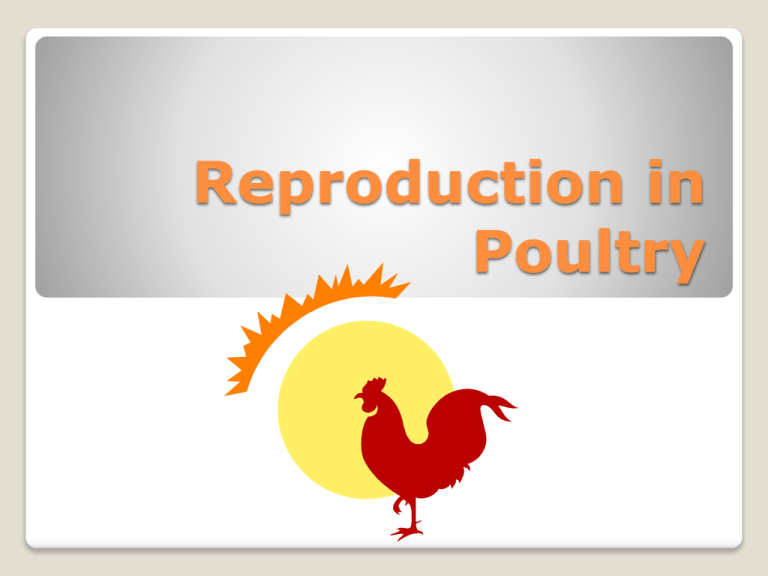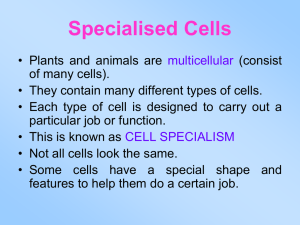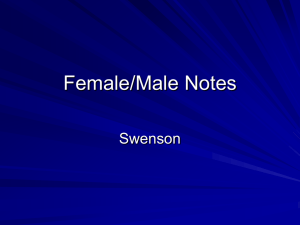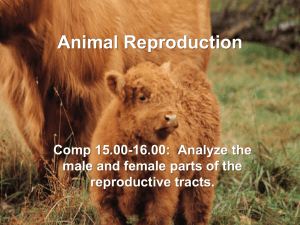
Reproduction in
Poultry
young
are not carried in
the hens body
develop inside a fertilized
egg outside the hens body
Different from
mammals
begins
with male placing
the sperm into oviduct of
the female
male papillae deposits
sperm in cloacal wall of
female
Process
sperm
move up the
oviduct to the funnel
where the egg is fertilized
sperm cells remain in
oviduct 2-3 weeks after
mating
Process
sperm
have full fertilizing
ability for about 6 days
after then - ability of
sperm to fertilize egg is
decreased
Process
Structure and Function of the
Reproductive System in Poultry
The reproductive anatomy of poultry
differ when compared to that of other
animal species.
Male Reproductive System in Poultry
The male poultry anatomy consists of two testes (each with an
epididymis and vas deferens) that lead to papillae and a
rudimentary copulatory organ.
Male Poultry Reproductive Tract
Unlike other livestock species, the testes of
poultry are located within the abdominal
cavity along the backbone.
The epididymis, which still functions in
sperm storage, is relatively small in relation
to the testes.
The vas deferens extend from the
epididymis to the cloaca and are located on
each side of the vertebral column.
The vas deferens extend from the
epididymis to the cloaca and are
located on each side of the vertebral
column.
The vas deferens function in
transportation of sperm and as sperm
reservoirs.
Cloaca – the lower end of the avian digestive tract that provides
a passageway for products of the urinary, digestive, and
reproductive tracts.
Papillae – located at the end of the vas
deferens and on the floor of the cloaca, the
` papillae emit semen into the cloaca of the
female.
Phallus – a rudimentary copulatory organ
that becomes engorged with lymph during
mating, which allows semen to be
deposited onto the female’s everted
cloacus; the phallus is more developed in
ducks and geese.
Androgen – the male sex hormone produced by the testes.
Functions of androgen include:
• Directing sexual activity and the
production of sperm,
• Controlling secondary sexual
and
characteristics of the male,
• Influencing social rank or “peck
order.”
Secondary sexual characteristics of include comb growth, crowing
or gobbling, spur development, and male feathering.
Female Reproductive System in Poultry
The functional parts of the female poultry reproductive tract
includes one ovary, an oviduct, and the cloaca.
Female Poultry Reproductive Tract
Mature female poultry have only one functional ovary; the
right ovary and oviduct degenerate and cease functioning
before the bird reaches sexual maturity.
The ovary appears as a cluster of tiny, gray balls that are the
oocytes.
At maturity, the ovary contains up to 4,000 tiny oocytes from
which ovum may develop over time.
An ovum develops by collecting lipid particles from the blood
to form the yolk.
The yolk contains fat for energy and some protein and other
nutrients needed by the developing embryo, as well as, a small
white dot called the blastodisc that contains the genetic
information supplied by the female.
When mature, the yolk is released by the follicle and engulfed by
the infundibulum.
The oviduct is about 25 inches long and consists of five parts: the
infundibulum, the magnum, the isthmus, the uterus, and the
vagina.
Infundibulum – funnel-like part of the oviduct that receives the
yolk and is the site of fertilization.
Magnum – second part of the oviduct that secretes the thick white
or albumen.
Isthmus – third part of the oviduct that adds the two shell
membranes.
Uterus – the fourth part of the oviduct that secretes the thin white,
the shell, and the shell pigment.
Vagina – the last part of the oviduct that holds the egg until it is
laid.
From the oviduct, the egg passes to the cloaca and then out of
the body through the vent at the time of laying.
In addition to producing ova, the ovary produces the female sex
hormone, estrogen, and the hormone androgen.
The androgen hormone stimulates comb growth and works with
other hormones in egg production.
In poultry, the functions of estrogen include:
• stimulating the growth of the oviduct,
• increasing the size of the cloaca
egg laying,
during
• modifying feather shape and
pigmentation of the female, and
• increasing the level of fat, phosphorus,
and calcium in the blood.
D. Describe the poultry reproductive system
Rooster
Testicles
Vas deferens
Cloaca
Testicles: Produce sperm
Vas Deferens: Carries seminal
fluid and sperm from testicles to
cloaca
Papilla: The organ in the wall of
the cloaca that places the sperm
inside the female’s reproductive
tract
Hen
Ovary
Magnum
Infundibulum
Isthmus
Uterus
Vagina
Cloaca
Ovary: Produces the ovum
Infundibulum: Receives yolk from ovary, where
sperm is stored, and fertilization takes place
Magnum: Secretes the thick white of the egg
3 Hours
Isthmus: 2 shell membranes are placed around
the yolk and thick white
1 ¼ Hours
Uterus: Thin white and outer shell are added to
the egg
20 Hours
Vagina: Completed egg is stored for a short
time til laid
Total: 25-27 Hours
1 Infundibulum
2 Magnum
inside)
4 Uterus
5 Vagina (with egg
Egg Processing Video
Germinal Disc
Yolk Membrane
Yolk
Air
Cell
Thick White
Outer Shell
Thick White Membrane
Thin White
Outer Shell Membrane
Compare Mammalian and Poultry Reproduction
2 functioning
ovaries
2 ovaries, but only
LEFT ovary
functions
Sperm cells are
only viable for a
short time after
depositing into the
female
Sperm cells live for
atleast 6 days…and
as long as 10-15
days!
Testicles are inside
the scrotum on the
OUTSIDE of body
Separate exits for
the urinary,
digestive, and
reproductive tracts
Testicles are
INSIDE the body
cavity
ONE exit from the
body (vent)
E. Describe environmental requirements to
hatch chicken eggs
Natural:
•Hen lays eggs (1 per day) over
period of several days
•When she has an adequate
nest, she begins to lay on them
to keep them warm
•After 21 days, the eggs hatch
•A hen who is laying on her eggs
is referred to as “broody”
E. Describe environmental requirements to
hatch chicken eggs
Artificial Incubation:
•Hen lays eggs and they are
placed in an incubator
•Incubator keeps eggs at proper
temperature and humidity
-Temperature: 102-103 degrees
-Humidity: 60%
•Eggs are turned 2 times daily to
prevent embryo from sticking to
the inside of the shell
E. Describe environmental requirements to
hatch chicken eggs
F. Candle eggs to determine their interior and
exterior quality grade.
Grading Exterior Quality:
1-Cleanliness
- Shell should be free of
debris or organic matter
2- Shape
-small end and large end.
Not round or oblong
3- Soundness
-No Cracks
F. Candle eggs to determine their interior and
exterior quality grade.
Grading Interior Quality:
1- Air Cell
2- Viscosity of Albumen(white)
3- Check for abnormalities
-Blood/Meat Spots
-Cracks or leaks in shell
F. Candle eggs to determine their interior and
exterior quality grade.
Egg Quality Grades:
AA
A
1/8 inch (Dime)
3/16 inch (Nickel)
B
3/8 inch (Quarter)
F. Candle eggs to determine their interior and
exterior quality grade.
Albumen Viscosity
1-Hold egg up to light
2- Twist egg rapidly and watch to
see how much the yoke moves around
AA
Egg Quality Grades:
Little
movement
A
Some
movement
B
Lots of
movement
F. Candle eggs to determine their interior and
exterior quality grade.
Loss
Any of the following would result in
the egg being graded as a “loss”
-Blood/Meat Spots
-Cracks or leaks in shell
10th
day - 50% ability
19th day - 15% ability
Sperm viability
after
yolk is fertilized it
moves through the tract
where the rest of the egg
is added
egg is laid - embryo grows
inside the shell
Process
keeping
eggs at the right
temperature and humidity
for hatching
hen does this by sitting on
the eggs
Incubation
commercial
hatcheries use
mechanical incubators
incubation of chickens is
21 days
Incubation
temperature
102 - 103 F.
RH - (relative humidity)
60% for the first 18 days
RH 70% for the last 3 days
Incubation
eggs
are turned twice daily
for the first 15 days
keeps the embryo from
sticking to the inside of the
shell
Provide a small amount of
oxygen
Incubation
has
five parts
Funnel - receives the yolk
from the ovary
sperm cells received from
the rooster are stored here
Oviduct
secretes
the thick white of
the egg
It takes three hours for
the thick white to be
placed around the yolk in
the magnum
Magnum
the
yolk and thick white
then moves to the Isthmus
2 shell membranes are
added
It takes 1 1/4 hours
Isthmus
thin
white and outer shell
are added to the egg in
the uterus
egg remains in the uterus
about 20 hours
Uterus
after
the egg is completed
it moves to the vagina
stays in the vagina for a
short time and is then
expelled from the hens
body
Vagina
It
takes 25-27 hours for a
chicken to produce one
egg
One egg
In
the chicken only the left
ovary and oviduct function
the ova produced in the
ovary develop into egg
yolks
Ovary
general
physical condition
of animal
has an effect on the agility
to reproduce
Reproductive
Failures
too
fat or too thin may not
become pregnant
proper nutrition and
exercise can help prevent
this
Reproductive
Failures
animals
in poor physical
condition can have trouble
giving birth
Reproductive
Failures
affect reproductive
some may prevent
organs
pregnancy
others may cause a
spontaneous abortion miscarriage
Infections
if
animal does become
pregnant it may deliver a
weak animal which may
not live
Infections
of
uterus
almost always fatal to
embryo or fetus
Infection
sexual
behavior of animals
is regulated by the
secretion of hormones
when not properly
secreted the animal may
not be able to reproduce
Hormones
sometimes
animals are
treated with injected
hormones
Hormones
swelling
containing fluid or
semi solid substance
may cause reproduction or
breeding problems
may be surgically removed
depending on the value of
the animal
Cyst








